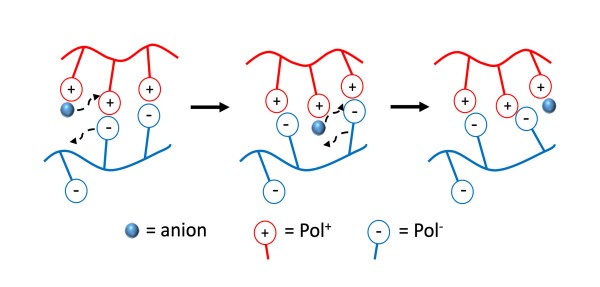Understanding Viscosity of Entangled Polyelectrolyte Coacervates
December 15, 2020

A short local section of polyelectrolyte coacervate chains, showing 3 repeat units of polycation (Pol+) paired with repeat units of polyanion (Pol-). Coacervate viscous flow involves detachment of Pol+Pol- pairs and reforming of such pairs with neighboring repeat units. Such hopping of ion pair bonds may be accompanied by the exchange of small counter ions (anion), such as chloride in the present case. Theoretical consideration of the required correlation of hopping events that enables flow of entangled chains, explains the unusually strong dependence of viscosity on the fifth power of chain length.
Scientific Achievement
Interactions in randomly coiled polyelectrolyte coacervates (PECs) lead to a viscosity proportional to the fifth power of chain length, a previously unknown regime.
Significance and Impact
Interactions in PECs are analogous to those in other processes, for example biologically significant sieving of DNA strands through nanopores, and therefore the dynamics discovered here may be relevant to them as well.
Research Details
- PECs with high molecular weight and low polydispersity were prepared via careful fractionation.
- SANS showed that the conformation of the polymer chains were equivalent to a Gaussian random coil.
- Polymer chain dynamics as function of chain length were determined from rheology measurements.
“Ultraviscosity in Entangled Polyelectrolyte Complexes and Coacervates,”
Khalil Akkaoui, Mo Yang, Zachary A. Digby, and Joseph B. Schlenoff,
Macromolecules 53, 11, 4234-4246 (2020).
DOI: https://doi.org/10.1021/acs.macromol.0c00133


